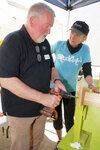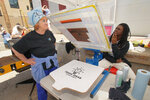By Jan Willms
What are the biggest barriers to young people succeeding in the Twin Cities? Are there enough resources to assist youth facing overwhelming challenges? Are those resources readily accessible? And what more can be done?
These questions were recently asked of some veteran youth workers who have been up close and personal with the challenges and barriers that are prevalent with many of the young people they engage with.
JEAN FAWVER
Jean Fawver is a special education teacher and work-based learning coordinator around transition and employment at Avalon School in Saint Paul. She is in her third year at Avalon and has taught special ed for seven years. Prior to that, she did youth development work in Minneapolis Public Schools.
“From my perspective, I am working primarily with students with disabilities and how that may affect their entry into employment,” Fawver said. She said she works more with what is going on outside of school, around housing and the stress that families may be experiencing, and how that impacts students’ ability to show up and do what is required at school.
“Since the pandemic, the needs of mental health impose barriers,” Fawver said. “The stress and level of anxiety young people are facing are pretty significant. As is the lack of access to support for those needs. Throw into that family problems, and employment is kind of the last priority, although it is an important piece.”
Fawver said she thinks the real gaps in mental health care and housing are huge. “The other thing I see is lack of transportation and driver’s licenses. Those are real barriers to high paying jobs in the area.”
Fawver said there are some good programs out there, such as the trade programs through the Finishing Trades Institute and Drivers License Academy through Ramsey County, but youth must be 16 to 18 to enter some of these programs. She said she would like to see programs for younger youth so that they can transition into some of these other classes.
“Autism is being recognized more, at least here at our school,” Fawver continued. “Many of our students are on the spectrum, and some of that group in particular struggle with barriers to employment.
“I see people are becoming more educated around this, and I definitely see improvement and more integration and opportunities,” she continued. She added that she thinks schools can do a better job of preparing students for the work setting and the social demands of a work environment. “We could provide a lot more support,” she said. “And lack of literacy skills is another big barrier. Some of our students with learning disabilities are reading at a second or third grade level, and that is a huge barrier for them.”
According to Fawver, many students get hung up by the job application process. “It is an overwhelming task for some of our students just to read emails,” she noted. ”We make assumptions about how tech savvy our youth are, and they may be good at texting and TikTok, but not at professional communication. We just assume they know things that they don’t know.” Fawver described one of the biggest joys of her work that continuously motivates her is when she and other staff are able to get students past barriers and start to feel successful.
NINA MCGARRY
For 25 years, Nina McGarry has been a social worker with the Journeys Transition High School program in Saint Paul. She has previously worked in Montana schools doing team-building with elementary children. She was also a Wilderness guide in northwestern Montana for eight years, working with youth at risk.
“I think one thing that has taken me a long time to realize is that every person’s situation is so different,” McGarry said. “I might work with an unaccompanied youth who has the strongest work ethic. One youth might have a disabled parent who has never worked. Circumstances have been so different for each one. Some families may have a low income, but a strong work ethic and would never take money from the system.” She said that no matter what the circumstances are, however, there can be a need for help in certain areas. “As social workers, we identify what those areas are and help with them.”
McGarry said that all the youth she works with are in special ed. But as part of her program, she has worked with kids in the Juvenile Detention Center. “These are youth who fell through the cracks and became incarcerated,” she said. She said when they are released, they can disappear.
But she said with incarcerated youth who are released and return to Journeys, she has seen an employment group helping to remove barriers. She said these youth received internships that were very targeted to them. “These youth did not have to get frustrated at not finding a job,” she said. “These were paid internships, so there was money coming in, too. My kids thrived.”
She said these kids had no idea where to look for a job, were nervous about showing up and did not know what their skills and abilities were. She added that kids in homeless situations or in foster care could be vulnerable, too.
“The more risk factors there are, the harder we need to look at what might be needed,” McGarry said. She said the streamline into supportive housing is challenging. “There is very devoted homeless staff in this community, but homelessness can absolutely turn things around. ‘Where can I get food? Where can I go next?’ The youth can have excellent work skills and be accountable, but it is such a struggle.” McGarry said she does believe that agencies and organizations are getting better at providing resources for young people in need. “Kids do see a path to moving up, and they are coming with a better vision of the future, even the ones who fall through the cracks,” McGarry said. “The community is better at finding strengths, removing some of the barriers and having an upward trajectory. We cannot just stop when they enter training. There is going to be a lot of work, not just one and done.”
GRETCHEN WILBRANDT
Gretchen Wilbrandt has been the director of development and community engagement at Urban Boatbuilders since September. She has also been a teacher, a consultant, a PhD student, IT worker and with the Yacht Club. Urban Boatbuilders is a nonprofit in Saint Paul that teaches youth how to build boats through paid internships. ”I think everyone comes from a different situation, longing for a sense of community and support. We have fostered and developed that at Urban Boatbuilders,” she said. She remarked that the COVID generation wants a little bit more connection and wants to find ways to do that.
“We are looking to break down the silos between the nonprofit and for-profit industries,” Wilbrandt said. “We have a shortage of skilled workers, and we want to break down the wall between companies to let them know we are working to ensure we have employable youths. We want to determine our young people are socially and emotionally ready. Helping connect them to stable employment is our mission.” She said her agency and others are impactful by offering career readiness programs.
“We have been talking about having some events this summer,” Wilbrandt said. “There are so many nonprofits along University Avenue. We have talked about getting together for a meet and greet or an eat and greet, or a lunch and learn. There is so much collaboration to be done.”
Wilbrandt said one of the greatest challenges youth seeking employment face is lack of a car and driver’s license. “You need a job to pay for a car, but you need a car to get the job,” she stated. She said a large number of youth are challenged by that transportation barrier. She said one company in Minneapolis will pick up employees from their doorstep to take them to work while they are getting a driver’s license and car.
“The lack of affordable housing creates a lot of instability on all levels,” Wilbrandt added. “I can’t imagine coming out of college now with debt and looking for that first job and a place to live, and making ends meet.
“Young people are facing so many challenges,” Wilbrandt continued. “Personally, I think there needs to be a paradigm shift in society that honors others, with more equity and more people need to care more about others.” She cited COVID, global wars and a mental health crisis as stressors that can make young people feel hopeless. “We need to help people around us and we need micro-communities that blossom. We need to care about other people and give them a chance. We don’t want to remove chairs from the table, but bring in more chairs to the table.” She said there is a need for inclusive conversation, actual listening, a breaking down of White supremacy and White saviorism.
PAUL RAMSOUR
Paul Ramsour is the executive director of Elpis Enterprises in St. Paul, a nonprofit that offers paid internships to homeless youth in screen printing, woodworking and bag manufacturing. Ramsour created the organization in the late 1990s. The nonprofit teaches soft skills in business, digital literacy and customer service, as well as the trades.
Ramsour, who has spent years in the youth work field, said he thinks barriers for young people are pretty much the same, with some nuances on each of them. “Being able to not only hold down a job but to think about navigating a career path and figure out the steps to get where you want to go in life requires some stability, whether it be in housing, transportation or health and wellness. I don’t think those things change a lot,” he said.
“Lots of people work from home these days, but you still have to apply job requirements, outcomes and responsibilities, and if you don’t have stability it is hard to maintain working from home. Working from home since the pandemic has changed the most, but most of our interns are not going to get work-from-home jobs.”
He said he has talked with several people who do programs similar to Elpis, and the conversations seem the same. “All the programs are affected by a lack of affordable housing,” Ramsour said. “People are having a hard time finding a place to live, and that affects their ability to come to work.”
Ramsour said both Ramsey and Hennepin counties are utilizing post-pandemic funding to work on youth services. He cited the Drivers License Academy helping youth get driving training and licenses as an example.
“But the problems are still the same,” Ramsour said. “Just having the funding to address those issues is not enough; you need people in those jobs who can focus. Caregivers are not always in a position to see that youth take advantage of the opportunities offered. Education and work are not priorities in the household. Or the primary caregiver has abdicated that responsibility to someone else, and other needs have taken over.”
He said that housing stability might be the highest priority, and education and training are not the main focus. “There is nobody there to push the youth to participate in these opportunities, and they miss out.
“I think from a health and wellness standpoint a lack of one good mentor to help youth to navigate and to be a sounding board when they run into trouble is a major barrier. They need someone to set an example in solving problems. The lack of a good mentor is a make or break situation for a lot of these kids.” Ramsour said having someone to help them prioritize and make good decisions is key for most kids.
“I always believe there’s hope,” Ramsour continued. “You have to be really intentional about what you do, and you have to stay active. You have to constantly ask who is not present, whether it is people in your neighborhood or kids on your block. You can’t get them all, but if you have an opening you can say we added one or two who would ordinarily not be here. You have to go and talk to the person who was not present, because that might be the life you change.”
JOEL SISSON
Joel Sisson is a performance artist in the Twin Cities who started the Green Chair Project around 1991. “Minneapolis was called Murderapolis because of all the gang activity. A police officer had been shot. That summer I had gotten jumped and beaten up by a handful of young guys. I wondered if I should leave the area.”
But then Sisson thought about if he were a young person growing up in the area and wondered if he would have acted much differently if there were no opportunities.”I also had an Adirondack chair stolen at the time, and a neighbor lady said we needed the chair back. So I thought, what if we hired young people to build chairs?”
Sisson said he and Chris Hand tore up their garden, built 100 chairs, painted them and gave them as gifts to their block.
He said the project showed that young people can be productive when given a chance. They continued building chairs for about 12 years. The project started again in the wake of George Floyd’s death in 2020. Sisson worked with Elpis’s woodworking department and started building chairs again. They used kits that open up and unfold, making two work tables with jigs attached. Others were shown how to build the chairs, spreading the project around the community.
Sisson said the challenge has always been how to reach young people and let them know about the opportunities that are out there for them. It is difficult to keep social media updated with all the summer programs available. “How do you connect with the ones who are falling through the cracks?” he asked.
Sisson applied for a grant to put information on the sides of buses and shelters, but then he followed a different path. He talked with Ramsour and Karl Erickson, the woodworking director at Elpis, about doing chair-building workshops and how to get the word out.”Out of our conversations, we talked about giving youths a handout telling them about how to prepare for job interviews and other job-seeking tools. We thought of something like a graphic novel, in comic-book-style that is culturally appropriate. We would like to find the right kinds of groups to make that happen,” Sisson said. He said he has made three little booklets that could be a point to start from.
“They could be done for each ethnic group, with words from elders and a list of resources,” Sisson said.
“This is something that could be done across the United States,” Sisson continued. “Each region and locality could use a template and then fill in their own blanks.”
Sisson said he learned about how to make public art a part of the community from Minneapolis College of Art and Design (MCAD) professor Kingi Akagawa. “He was really good about how an artist can respond to the public in his community,” Sisson said.
“We need to get people outside, talking to one another,” he said.
Editor’s note: Freelancer Jan Willms also works at Elpis Enterprises.







Comments
No comments on this item Please log in to comment by clicking here